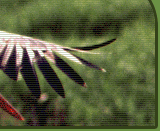| Management plan for Klani Mires Nature Reserve Expert studies have contributed to the information about the nature values species and species and habitat diversity in the site. Plant species: Flora of the territory has been studied 20 years ago when 527 vascular plant species were described and 158 bryophyte species. During the elaboration of the management plan the inventory of the habitats was carried out and the protection regime evaluated. From the earlier known 38 protected and rare vascular plant species 28 were found, but at the same time new species of Habitats Directive Annex II Liparis loeselii was discovered. Once again, 20 flowering specimens of Cypripedium calceolus Habitats Directive Annex II were found. After the fire in 2001 near Klani Lake Lycopodiella inundata has not been found, but Lycopodium annotinum occurs quite often (Habitats Directive Annex V). Invertebrates: In total 14 rare and especially protected species were found, from them 2 species of Habitats Directive Annex II which were not known before in the territory – Euphydryas aurinia and Leucorhinia pectoralis. In 2005 a new dragonfly species for Latvia was found there – Orthethum brunneum. Mammals: In total 15 species were found. In the territory Lutra lutra and Castor fiber (Habitats Directive Annex II and IV species); sometimes the footprints of Canis lupus and Lynx lynx were observed. Castor fiber with its dams helps to maintain an optimal water level for plant species in Klani Lake. Birds: Bird fauna has been studied in separate periods, starting already from 1980-ties. In the territory 22 protected species of Latvia and Bird Directive have been observed. Still, not every year nests Ciconia nigra. As a breeding place, the site is used by such species of Bird Directive, like Aquila pomarina, Pandion haliaeetus, and Haliaeetus albicilla. At the same often Bonasa bonasia and Caprimulgus europaeus are observed. The territory is highly suitable for Picoides tridactylus, Dendrocopos leucotus and Dryocopus martius. Two areas with Western taiga habitats were discovered that suitable Tetrao urogallus (one known from the project application, another is new). Management actions are planned to favour the establishment of Terao urogallus leks. Habitats: In total 9 habitats of Habitats Directive Annex I (from them 4 are priority habitats (7110*, 9080*, 91D0*, 9010*) and 10 protected habitats of Latvia were found in the site. Active raised bogs cover about 25 % from the total area. Still, due to drainage the raised bog vegetation has become degraded, especially near the ditches. Special value have the Fennoscandian deciduous swamp forests (9080*) as well as bog woodland (91D0*). An outstanding value has Klani Lake, where habitat of EU concern Oligotrophic to mesotrophic standing waters with vegetation of the Liitorelletea uniflorae and/or Isoëto-Nanojuncetea (3130) with Lobelia dortmanna and Myriophyllum alterniflotum occurs. Here also the increase of rare and protected plant species, such as, Lobelia dortmanna, Eleocharis multicaulis and Rhynchospora fusca was observed. The territory includes also forest openings where 2 habitats of EU importance were found (6410, 6210).
Conclusions about the negative factors influencing the territory: Forests - Digging of a canal in the 20-30-ties of the 20th century that caused drainage of forests;
- Forest and raised bog drainage that was carried out in 50-60-ties of the 20th century. As a result 35% of the forests were drained.
Raised bogs - Drainage was carried out in 50-60-ties of the 20th century. As a result one of the raised bogs of Klani Nature Reserve (Dziru Mire) was transformed into a forest; at least 80 ha of the mire became degraded;
- Renovation of the drainage ditches.
Forest openings – meadows - Termination of grassland mowing
Klani Lake - Digging of a canal in the 20-30-ties of the 20th century that caused lowering of the water level in the lake and a faster overgrowing as the lake became shallow;
- Spontaneous fires on the northern shore of the lake;
- Driving with motor vehicles along the shores of the lake;
- Lake changes more to a dystrophic type that can not be influence due to the geographic location of the lake.
Management actions are subordinated to the short-term conservation aims of the territory. In total 11 short-term aims that include 35 management actions are planned from which the main are: 1. Maintenance of raised bogs without any disturbance and allow the natural processes to proceed in the area; 2. Restoration of the degraded raised bog habitats and those influenced by drainage. It includes hydrological studies and elaboration of technical designs for building of dams on the drainage, control of the functioning of the dams; 3. Long-term maintenance of biologically valuable forests; 4. Long-term maintenance of the rare and protected habitats near Klani Lake, including hydrological monitoring, control of beaver activities in the canal, prohibition of beaver shooting; 5. Management of forest habitats suitable for the Tetrao urogallus; 6. Restoration and maintenance of valuable habitats for the invertebrates, mainly by mowing of forest openings and cutting of shrubs; 7. Establishment of information boards and signs, preparation of an informative booklet about the site, producing a film; 8. Monitoring the effects of the management actions on raised bog habitats; 9. Hydrological monitoring in the degraded and intact part of Klani Mire; 10. Lake water quality monitoring; 11. Monitoring of lake terrestrialization and the habitats of rare species near the lake ; 12. Monitoring of the habitat of Cypripedium calceolus.
| 







